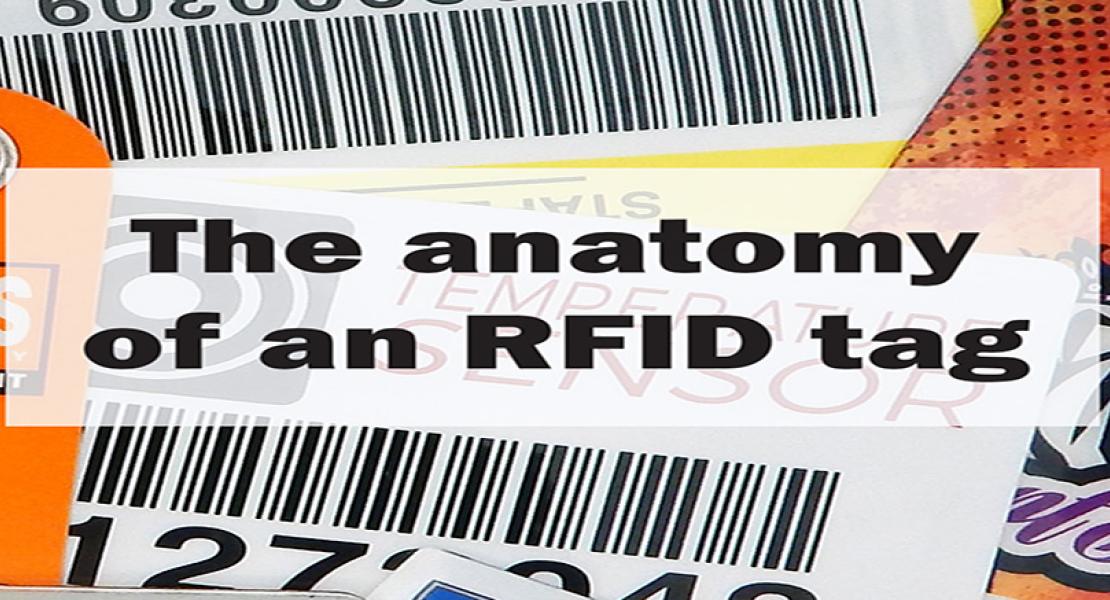RFID is an acronym for “radio frequency identification” and it has been in use since the early 1940s. RFID has come a long way - the technology has improved year over year and the cost of implementing and using RFID tags has dropped considerably.
RFID refers to a technology in which digital data encoded in RFID tags is captured by a reader through radio waves. These tags are a cost-effective and efficient way to automatically and uniquely identify and track inventory and physical assets.
But how are RFID tags made? In this article, we’ll discuss the RFID tag components and how they are constructed.
RFID tags are made of three components: an RFID chip that is comprised of an integrated circuit (IC), an antenna, and a substrate (an underlying layer/base).

RFID Chip (IC)
An IC, also known as an electronic circuit or microchip, is designed and manufactured by a semiconductor manufacturer. Contained within the IC is a logic unit that makes decisions and provides memory to store data.
The IC needs power in order to operate. How this power is obtained depends on the type of tag. In an active tag, the power comes from a battery on the tag, while in a passive tag, it is obtained from the radio energy radiated by the interrogator antenna.
The memory on the IC can be divided into various blocks, called banks. A block can be a read-only type, a write-only-one-time type, or a write-many-times type.
Data type stored depends on the protocol used. The IC can store tag ID, password, object identifier, and error detection codes (for example cyclic redundancy code).
ICs are created on a big semiconductor wafer, that can contain 40,000 ICs. They are manufactured in state-of-the-art clean room facilities. The finished ICs are individually tested in order to ensure reliability.
Thanks to the advances in technology, IC designs are becoming smaller, which significantly reduces the cost and power needed to function.
RFID Tag Antenna
The largest part of the tag, which is connected to the tag IC, is called the antenna. The RFID tag antenna receives signals from the interrogator and, depending on the type of the tag, it either transmits or reflects the received signal.
In the case of active tags, the antenna transmits the signals. In the case of semi-passive or passive tags, it reflects the signals. When it comes to the passive tags, the RFID tag antenna also collects power from the radio waves and supplies it to the IC.
The geometry of the antenna is determined by the tag’s operation frequency. Variations in antenna design allow tags to have distinct properties and behaviors. The antenna can have the shape of a spiral coil, a single dipole, dual dipole (two dipoles perpendicular to the other), or a folded dipole.
The antenna is designed for a specific frequency and is later tuned according to the properties of the materials to be tagged. This frequency determines the effective antenna length, but the actual length is typically reduced by design.
Antennas are usually made from thin metal strips of copper, silver, or aluminum. They are deposited on the substrate at high speeds via one of these three methods: copper etching, screen-printing, and foil stamping. Screen-printing is the fastest and the least expensive method, but it creates the least efficient antennas compared to the other two methods.
Substrate
The RFID tag substrate is the one that holds all the other components together. It’s important to know that the RFID tag antenna is deposited or printed on the substrate, and the IC is then attached to this antenna.
A substrate is generally made from a flexible material (such as thin plastic), but it can also be made from a rigid material. The majority of passive tags use substrates made from a flexible material.
This material must be able to withstand different environmental conditions that the tag encounters during its lifecycle. Some of the materials used for the RFID tag substrate are polymers, PVC (polyvinyl chloride), polyesters, Polyethylenetherephtalate (PET), phenolics, styrene, and even paper.
Regardless of the material used, it is essential that it provides a smooth printing surface for antenna layout, dissipation of static buildup, durability and stability under different operating conditions, and mechanical protection for the components and their interconnections.
The RFID tag substrate is designed to withstand environmental conditions such as heat, sunlight, moisture, chemicals, impact, abrasion, and corrosion. The substrate material may affect the design frequency of the antenna, so it’s important to consider the effect of substrate material during the proper tuning of the antenna.
One side of the substrate is typically coated with an adhesive material to attach the tag to an object. The adhesive material is designed to withstand various environmental conditions. In some cases, a protective overlay made from materials such as PVC lamination, epoxy resin, or adhesive paper is added in order to offer additional protection.
Bottom line: RFID tags help businesses unleash the power of their data. If you’re looking for a way to improve your ability to tag, track and manage your assets, make sure to check out our ID products - they provide an easy way to identify and tag items.
To learn more about our RFID tags, please contact us today at [email protected].
 | About the Author: Aaron HobertAaron Hobert is our RFID Technical Specialist. Hobert joined Metalcraft in September of 1994 as a Litho Press Operator, became the Autograph Team Lead in 1998 and in April 2005 he became the RFID Sales Support Rep. He was named our RFID Technical Specialist in 2008. Aaron lives outside Charles City with his wife Diane. Mobile Phone: 641-330-2660 Email: [email protected] Office: 3360 9th St. SW, Mason City, IA 50401 Office Phone: 641-423-9460 |




